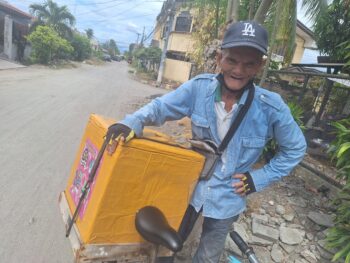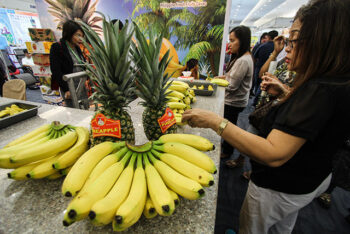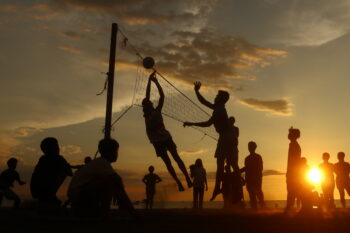Last of two parts | Read Part 1
When Rivers are Exploited for Agri-business Interests
CAGAYAN DE ORO CITY (MindaNews / 10 June) – From an economic perspective, the water resources in Bukidnon are a blessing. In fact, as of 2013, Bukidnon rivers supply water for the domestic needs of at least 550,000 households; 32,382 hectares of irrigated lands; 145,434 hectares of annual and perennial crops; 555 business establishments/agro-industries; and 320 livestock farms (e.g., poultries and piggeries).[1]
Because of its abundant water, Bukidnon is attractive to agricultural companies. In fact, Bukidnon maintains its image as agricultural province by accommodating the following large-scale monocultures: sugarcane, 7.8%; corn, 6.69%; pineapple, 2.06%; irrigated rice field, 2.06%; and other crops (e.g., rubber, banana, coconut, mango, cassava, etc.).[2]
As of now, the large agribusiness firms that operate in Bukidnon “include the Dole North/South Skyland (DOLE), Mt. Kitanglad Agric-Dev’t. Corp. (MKADC), Lapanday Dev’t. Corp., Davao Fruits Corp., Global Fruits and Del Monte Phils, Inc. (DMPI).”[3] They change the landscape of the province as they occupy prime lands and justify their agricultural activities in the name of development.
Is the presence of these large-scale monocropping agribusiness companies that heavily depend on toxic chemicals for production ecologically sustainable? Aside from contaminating the rivers, studies of human consumption also show that their presence is unsustainable as the vast majority of fresh water goes to agriculture (70 percent), followed by industrial uses such as manufacturing (22 percent), and trailed distantly by domestic uses (8 percent).[4] These extractive practices “contribute in rather direct ways to the depletion of fresh water supply, water scarcity and eventually, crisis.”[5] It would be a great scandal for a headwater province like Bukidnon to experience freshwater crisis in the long run.
The Conflicts Over Damming the Pulangi River
The National Power Corporation (NPC), which supplies almost the entire energy demand of Mindanao, launched several projects to dam the rivers of the island for hydro-electric power. In Bukidnon, there were instances when the plan to dam the Pulangi river has become the source of conflicts between the project proponents and the local residents who were affected by these projects.
Let us call to mind the conflict that occurred in October 1981 when the people in San Fernando, Bukidnon organized themselves to peacefully oppose the plan of the NPC to dam the Pulangi river for a hydroelectric power. Fortunately, this conflict was short-lived as the parishioners, with the support of church missionaries, successfully resisted this government project, which would have drowned a large portion of their town and displaced more than 35,000 of its local residents.[6]
However, another conflict emerged in 1993 when the NPC presented a project to establish the Pulangi V Hydro-Electric Power Plant (HEPP) in Sitio Mikasili in Barangay Tangkulan, Damulog, Bukidnon. The local people initially resisted as this project would inundate some 3,500 hectares of land, including four adjacent Bukidnon municipalities (i.e., Damulog, Kibawe, Kitaotao, and Dangcagan) and the municipality of President Roxas in Cotabato. Accordingly, the construction of the project would have started in 1996 but it was prematurely shelved due to the Asian Financial Crisis in 1997.
When this project was revived in 2010, the First Bukidnon Electric Cooperative (FIBECO) was tasked to do the social preparation. To help the affected people make an informed decision in light of the common good, the Diocese of Malaybalay intervened by requesting the MedNet, a non-governmental organization, to study the pros and cons of the project. The MedNet survey in 2013 reveals that the people’s resistance of the project “revolves around competing rights and interests of primary stakeholders centered on land, its benefits and cultural value.”[7] There is also an ecological dimension of their resistance as the “respondents foresee devastation and ruin of trees.” In fact, “36.1% of the respondents anticipate devastation, ruin, or damage of rivers. One third of them expect that rivers will widen or become huge.”[8]
Aside from maximizing Pulangi river’s potential for hydro-electric power, the proponents of this multi-million-dollar project are also under pressure to meet the increasing demand for electricity. Presently, the Pulangi IV HEPP is forced to operate at 50% capacity largely due siltation problems. Hence, to augment this limited output, they hope that the operation of Pulangi V HEPP would “generate up to 300MW additional capacity and 1,256GWH of annual energy to the Mindanao Grid.”[9] For this reason, there is a rumor to implement this pending proposed project.
The Rivers Have the Right to Exist
Today, many water sources in Bukidnon have been privatized for marketization purposes. This brings us to the question of water as a human right. It can be recalled that access to fresh water was not officially recognized as an explicit right in the 1948 Universal Declaration of Human Rights because it was assumed to be self-evidently vital and considered “so fundamental that its explicit inclusion was thought unnecessary.”[10] It was only on July 28, 2010, that the UN passed a General Convention that officially recognized access to water and sanitation as universal human rights.
The Church affirms the fundamental human right to fresh water. Water is not simply an economic commodity but presupposed in the human right to life, to food and to health. Pope Francis stipulates that “access to safe drinkable water is a basic and universal human right, since it is essential to human survival and, as such, is a condition for the exercise of other human rights” (Laudato Si’, no. 30). Access to fresh water may be called “truly a right-to-life issue” in the sense that it is a basic requirement for the most basic forms of survival.
To end this article, it has been proposed that rights to freshwater is more than a human entitlement issue. Thus, it is good to ask whether or not rivers exist only for human beings. Do they have the right to exist for themselves—regardless of whether or not they are useful for human beings? Do they have a value in themselves apart from their instrumental value for human beings? As one theologian puts it, “might water ‘itself’— however understood — have a right to exist, for example in an uninterrupted, undredged state? Might this slippery substance be deserving of rights?”[11] I personally will not hesitate to answer these questions with a resounding YES!!!
[MindaViews is the opinion section of MindaNews. Reynaldo D. Raluto is a Roman Catholic priest of the Diocese of Malaybalay. He is the Academic Dean of St. John Vianney Theological Seminary in Cagayan de Oro where he also teaches fundamental/systematic theology and Catholic social teaching. He is the author of Poverty and Ecology at the Crossroads: An Ecological Theology of Liberation in the Philippine Context (Quezon City: Ateneo de Manila University Press, 2015). His ecological advocacy includes planting/growing Philippine native trees, mountain climbing, and defending the rights of Indigenous Peoples.]
[1] See Bukidnon Environment and Natural Resources Office (BENRO), “Environmental and Natural Resources Management” (unpublished Forestry Programs and Projects CY 2011-2013, BENRO, Malaybalay City, 2011), 2-3.
[2] See Environmental Science for Social Change (ESSC), Final Report: Land Use/Cover Update for Bukidnon Using Satellite Remote Sensing, (unpublished Report submitted to the Provincial Governor’s Office, Province of Bukidnon, April 2006), 20.
[3] See Province of Bukidnon, “Agriculture: Province of Bukidnon”; available online: https://bukidnon.gov.ph/2012/11/19/agriculture/ (accessed: September 14, 2019).
[4] See the Circle of Blue infographic, www.circleofblue.org; cited in Christiana Peppard, Just Water: Theology, Ethics, and the Global Water Crisis (New York: Orbis Books, 2014), 23.
[5] Peppard, Just Water, 23.
[6] See Jun Jabla, Defending the Forest: A Case Study of San Fernando, Bukidnon, Philippines (Davao City: Kinaiyahan Foundation, 1990), 26-28.
[7] MedNet, “Perceived Socio-Economic Effects of the Proposed Pulangi Dam V Project among Residents in Selected Affected Areas in Bukidnon” (unpublished Census Results on Pulangi Dam V, Malaybalay City, 2013).
[8] Ibid.
[9] Ibid.
[10] Maude Barlow, “Our Right to Water: A People’s Guide to Implementing the United Nations’ Recognition of the Right to Water and Sanitation,” The Council of Canadians (June 2011), http://www.canadian.org (accessed: September 15, 2019).
[11] Peppard, Just Water, 426.







